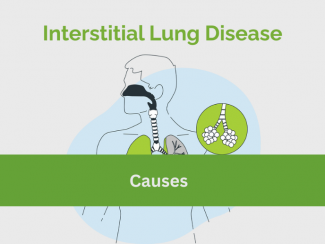Interstitial lung disease (ILD) is an umbrella term used for a large group of diseases that cause scarring (fibrosis) of the lungs. It affects millions of people globally. It is a serious condition that impacts mortality and quality of life of people affected by it.
ILD is different from COPD (Chronic Obstructive Pulmonary Disease)

The following are some of the causes and risk factors of ILD
- Genetics, lifestyle habits, environmental factors
- Some medications or other medical conditions such as hepatitis C, tuberculosis, pneumonia, COPD or Chronic Pulmonary Obstructive Disease may cause ILDs.
- Idiopathic pulmonary fibrosis (IPF)- when the cause is “unknown”
- Exposure to dust or mold in the environment may also cause some ILDs like asbestos-related lung diseases, hypersensitivity pneumonitis, etc.
- Some ILDs are more commonly found in men like Idiopathic pulmonary fibrosis (IPF) while lymphangioleiomyomatosis (LAM) mostly affects women.

Changed
21/Apr/2025
Community
Condition

















